Exhibiting Your Work | Art is a Real Job
Showing and touring work connects artists with communities and audiences, enhances gallery programming and amplifies and celebrates investments in artists’ work.
Showing and touring work connects artists with communities and audiences, enhances gallery programming and amplifies and celebrates investments in artists’ work.
This panel exchange took place during Art is a Real Job: Exhibiting Your Work on 9 March, 2023. Artists Tim Meakins, April Phillips and Thomas Readett discuss exhibiting their work with NAVA’s Alise Hardy.

Image: Supplied by Artist.
ID: Artist Tim Meakins smiling and peering above his artwork. The artwork includes a pink character on a black background surrounded by a thin yellow inner frame and thick silver outer frame.
He/Him
Tim Meakins is an artist and graphic designer based in Perth (Boorloo), Western Australia. Working across sculpture, painting, print, animation and publishing, he employs a visual grammar drawn from the history (and present) of computer graphics/operating systems and cartoons to create intensely energetic propositions around the ever-mutating forms, limits, plasticity, optical register and possibilities of digital and analogue states-of-being.
Studying design, Tim used illustration as a creative escape before exhibiting for the first time in 2018 with his first solo show Big Kicks. He now uses his design skills to produce the creative concepts and drawings for his work that are rendered in virtual reality before being brought to life in collaboration with fabricators.
He has since exhibited nationally and internationally including at Goolugatup Heathcote in Perth (2023); OOP Festival in Seoul, Korea (2022); Outerspace in Brisbane (2022); Art Gallery of Western Australia in Perth (2021); Tributary Projects in Canberra (2021) and Cool Change Contemporary in Perth (2019).
Instagram: @tim__meakins
Website: tim-meakins.com

Image: On Jackston Street
She/Her
April Phillips is a Wiradjuri-Scottish artist of the Galari peoples based in regional NSW. She is also an educator, graphic anphrpologist and audience specialist.
April’s arts practice is experimental, mixing analogue mediums with digital arts; this includes illustration, AR research and printmaking. April leans into character design and the representation of bodies as a narrative tool to explore empathy, fun and form. Her use of vivid colour and unlikely digital processes celebrates the potential of computer art for a new world.
April holds a Bachelor of Creative Arts and Design, and is currently obtaining a Masters of Education with a double specialisation: Design and Technology and Visual Arts. Her previous clients include: Australian Parliament House, National Gallery of Australia, National Portrait Gallery, Awesome Arts, Museum of Australian Democracy and the Art Gallery of SA.
Instagram: @_april.p_

Image: Supplied by Artist
He/Him
Thomas Readett is a Ngarrindjeri artist who was born and raised on Kaurna Yarta in South Australia, where he continues to practice and live. His practice spans drawing, painting ,video, music, advocacy and education.
For Thomas, creativity is an opportunity for self-exploration. The personal narratives that allow his work to lean into themes of love, loss, and grief are communicated with his audience with a powerful graphic aesthetic. Most often rendered in black and white, Thomas is an artist who is influenced by both street art and his classical training. He produced work that is technically and conceptually defined. In his recent works he pushes his practice to become sculptural and plays with the work’s pictorial plane, interrupting our usual modes of interpretation.
Thomas has exhibited solo shows Beneath the Skin, Dark Light, From Within, Complexities and First Person(s) with works developed through studio practice and artist residency programs such as the SALA Country Health SA and University of South Australia Glenside Mental Health residency.
Instagram: @trvisualarts
Website: trvisualarts.com
Finding ways to test your ideas and reach an audience is fundamental to working as an artist. There are several types of spaces to consider when exhibiting your work.
Public galleries provide artists with a platform to present and communicate their work. An exhibition may contribute to creative and critical discourse, award a prize or engage visitors and communities. There are over 400 public galleries in Australia. Public galleries are not-for-profit, non-commercial spaces, including major institutions (national, state and territory galleries), and the small-to-medium sector galleries (contemporary art spaces, contemporary craft and design spaces, galleries and art museums). It’s important to consider that the spaces that host exhibitions are not always physical with online exhibitions becoming increasingly popular. Exhibitions may include work on loan from the artist, work from collections, digital reproductions, and/or new commissions. Artwork may be shown as part of solo or group exhibitions, collaborations, festivals/events and more.
Read more about exhibiting in public galleries in the Code of Practice.
A successful relationship between an artist and a commercial gallery is mutually beneficial. Commercial galleries support and promote artists with the aim of developing the artist’s career and selling their work.
The artist and gallery should have a strong, healthy relationship that is unique and personal, and usually long term. The gallery will actively work with the artist to develop and sustain their career through exhibitions, networking, connections with collectors, promoting the artist and their work, and arranging other opportunities like speaking or workshops.
Commercial galleries generally act as agents for artists and sell artworks on consignment under an agency agreement. Other commercial gallery models include one-off exhibitions, multiple sales outlets and works purchased outright.
Read more about commercial galleries in the Code of Practice.
Artist Run Initiatives (known as ARIs and pronounced ‘ah-ree-s’) occupy a unique place within the Australian arts ecology that is considered separate from contemporary arts organisations, collecting institutions, commercial galleries, university-affiliated galleries and government-run arts facilities.
ARIs vary significantly in purpose, operation, scope and longevity. They can form around an art form, location or community, for purposes such as running a gallery, facilitating studio spaces, or publishing work. They often emerge in response to perceived limitations, gaps or opportunities within the sector or existing organisational frameworks.
ARIs can usually be distinguished from these organisations as they are governed predominantly by artists and tend to be less hierarchical in structure. Some may involve curators, writers, arts administrators and people from other creative fields like design and architecture.
ARIs are incubators for some of the most exciting, adventurous and responsive art in our communities. Often working with limited funds, ARIs rely on sturdy structures of volunteers, aligned values and good practice processes to ensure they benefit all members.
Public art is art that is made with the specific intention of being situated and exhibited in the public domain. This is often outside, and intended to be accessible to a wide audience and is often commissioned by governments, building developers and other organisations.
Public art includes a wide range of art forms, such as:
Public art may be site-specific, with the artistic vision of the project drawing from and adding to the meaning of a particular site or place. Temporary public art is a durational or ephemeral artwork which is exhibited, installed or performed in public space for a specified amount of time. Temporary public art is designed to leave no permanent structures, alterations, fixtures or fittings.
Read more about exhibiting in public spaces in the Code of Practice.
Discover more about exhibitions and showing your work in the following Code of Practice chapters:
Find NAVA resources about exhibiting:
Both artists and organisations have responsibilities as part of an exhibition. These responsibilities exist regardless of whether an exhibition is initiated by the host organisation or if the artist responds to an exhibition call-out with an exhibition proposal. Many of these responsibilities are often required to be addressed as part of an exhibition proposal.
Artist’s responsibilities when exhibiting their work include:
Read more about artist responsibilities in the Code of Practice.
Write an exhibition proposal, before installing and showing one of your art works. Choose a space for your exhibition and submit your proposal to the relevant organisation (i.e. your school, local government, or online space). Your exhibition proposal should include an exhibition outline, installation description, wall texts, floor sheets and visual documentation.
Research your ideas thoroughly to create a multilayered concept and to understand where your exhibition sits within historical and contemporary art making.
Provide a description of how you will install the works in your exhibition. Include the materials and tools you’ll need to install the artworks.
Think about how you will identify each work and whether you will have additional text about each work that contextualises it within the artist's border art practice and/or the exhibition framework. Texts within the exhibition should use concrete or simple language, and be kept short (approximately 150-200 words).
Wall texts and floor sheet listings should include:
Include visual documentation to give the reader a sense of what the work and exhibition will look like. To do this you could include:
Art is a Real Job was a national program throughout March 2023 that invited artists to share how good industry practice helped shape their careers and navigate the art world with confidence. The program dissected and championed NAVA’s new Code of Practice via four artist-led online events, including workshops, studio tours and panel conversations for secondary school student artists, educators and pre-service educators.
Artists Thomas Readett, April Phillips, Tim Meakins
Host Alise Hardy | Support Emma Pham
Hero image artwork Emma Pham
Program Manager Alise Hardy
Artists Annika Romeyn, Carly Tarkari Dodd, Sally Craven
Host Alise Hardy | Support Emma Pham
Hero image artwork Emma Pham
Program Manager Alise Hardy
Artists Sam Gold, Nikki Lam, Lisa Sammut
Hosts Penelope Benton, Emma Pham | Support Alise Hardy
Hero image artwork Emma Pham
Program Manager Alise Hardy
Artists Kay Abude, Rachel Burke, Ryan Presley
Hosts Emma Pham, Georgie Cyrillo
Hero image artwork Emma Pham
Program Manager Alise Hardy
Resource written by Alise Hardy.
First published in June 2023 by National Association for the Visual Arts as part of the Art is a Real Job.
Art is a Real Job is supported by the Copyright Agency Cultural Fund.
